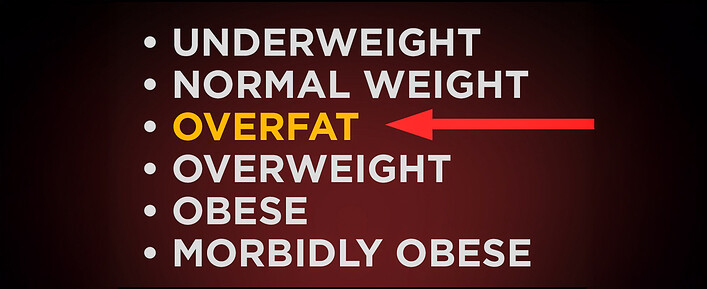by Chris Shugart
The Maffetone Method
You may not be overweight, but most people are overfat according to one study. Are you? Find out in one minute. Here's how.
90% of Men, 80% of Women
That's about how many people are "overfat" according to a recent study. That means, statistically, YOU are overfat. And that overfatness can lead to cardiometabolic dysfunction and a whole bunch of chronic diseases that'll kill you until you're dead.
Wait, What Does "Overfat" Mean?
Think of it as a new category on the body fat continuum:
The problem? "Normal weight" and the three latter categorizations of fatness are typically measured using the BMI scale. As you know, this is an oversimplified formula based on height and weight. It does not discriminate between muscle mass and fat mass, nor does it tell you anything about WHERE you store your fat.
That last bit is important. First, storing fat in the abdominal/belly area is much worse for you health-wise than storing it elsewhere.
Second, BMI doesn't tell you a damn thing about visceral adipose tissue and subcutaneous adipose tissue. Visceral fat is stored inside the abdominal cavity and around your internal organs. That's the stuff that'll most likely lead to insulin resistance and, generally speaking, dying in an assortment of nasty ways. Subcutaneous fat is that jiggly stuff just beneath your skin. It's less dangerous but definitely gross.
Australian health expert Philip Maffetone and his researchers believe that a person who's not obese or even overweight (as measured by BMI) can still have an unhealthy level of body fat – particularly in the abdominal region. That overfatness is either a sign of growing health problems or at least a predictor of soon-to-be health problems.
They think we should just do away with the confounding BMI scale and use something different. Their method is fast, simple, and will probably hurt your feelings.
Measure Your Belly
Here's the Maffetone method in a nutshell:
That's it. Strict? You bet, but their research is pretty compelling if you want to dig deeply into the study.
Wait, Am I Overfat?
You want to know, don't you? I sure did. So to help you break down that one-sentence fatness test, I'll use myself as an example:
- How tall am I? I'm 5'11". That's 71 inches. Half of that is 35.5.
- What's my waist measurement? Although Maffetone uses the term "waist," he really means "belly." The measurement should be taken across the belly button area. Your pants size is NOT your waist size. Here's the diagram Maffetone uses:
- My jeans size is 32, but my belly measurement is 34. That's the number we want, so get out the tape measure, don't suck in your gut, and do the deed. (I've always liked the MyoTape (Buy at Amazon) device for this.)
- Now look at the definition of overfatness again: "If the circumference of your waist measures more than half your height, you're overfat." My 34-inch belly measurement is not greater than half of my height – 35.5 inches. So, I'm not overfat.
How I'm Using This Info
Okay, I'm not overfat... but damn, that seemed close, didn't it? For reference, I have visible abs right now. Not dehydrated bodybuilder-on-stage abs, but pretty good. So maybe this test is a bit too harsh? Or is that just rationalizing? Either way, the Maffetone method made me step back and ponder. And ponderin' is always good.
The researchers here are focused on avoiding heart disease, the 13 types of cancer associated with being too fat, type 2 diabetes, etc. They're concerned with longevity and quality of life. Their test seems strict, but it's ultimately more reliable than BMI and more realistic for athletic folks. It's also easy to do at home.
I'm probably not going to freak out if I decide to go on a short-term mass phase and my numbers start to tip the other way just a smidge. But I'm definitely not going to stay in the overfat zone for long. The research is pretty clear: excess fat stored in and around your belly, even if you're not "overweight" by conventional standards, is bad news in the long run.
Oh, go ahead and reply with photos of World's Strong Man competitors with big waists and visible abs. Just remember, they're genetic mutants using tons of drugs and you're, well, probably not. (Also, their sheer "bigness" may be causing other issues.)
Health first, guys.
References
- Maffetone PB et al. "Overfat Adults and Children in Developed Countries: The Public Health Importance of Identifying Excess Body Fat." Front Public Health. 2017 Jul 24;5:190. PubMed: 28791284.
T Nation earns from qualifying purchases as an Amazon Associate. Read more about our policy.






